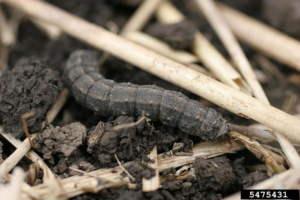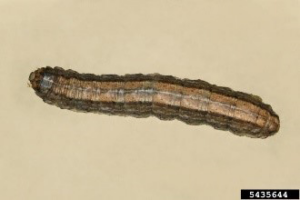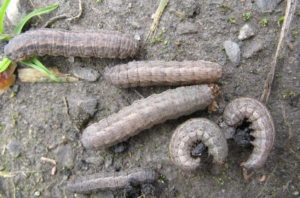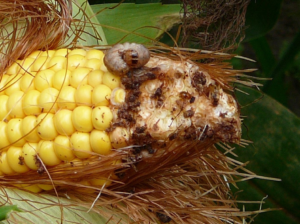Cutworms are typically an early-season corn pest and identification is important as many species can cause economic damage. Cutworm larvae typically hide under crop residue or soil and come out at night or on overcast days to feed on seedling stems near the soil surface. Regular field scouting is necessary when managing cutworms.
Black cutworm
Larvae are black to pale-gray and can be distinguished from similar species by the convex granules on the abdominal segments (Figure 1). Larvae increase in length as they grow from 0.25-inch (6.5 mm) at third instar growth stage to 2.0 inches (5 cm) at sixth to seventh instar. Damage from first to third instar larvae cause “shot-hole” leaf feeding while fourth to seventh instar larvae can cut plants at or below soil level. Larvae may also sometimes bore into and tunnel within the stem.

Figure 1. Black cutworm. Image courtesy of Roger Schmidt, University of Wisconsin, Bugwood.org.
Damage can be particularly severe in weedy, late-planted corn after a soybean crop and in corn planted in flood plains. Wet springs that delay tillage or herbicide burn-down applications are often associated with black cutworm outbreaks. In terms of economic damage, black cutworm is the most destructive cutworm species in the Corn Belt and can be found throughout North America. Larvae feed on many host plants including corn, vegetables, cotton, tobacco, and various weed species. For more information, see Black Cutworm in Corn.
Claybacked Cutworm
Larvae are pale-gray and translucent with a gray-brown head, bars on the front of the face, and a broad yellow-brown stripe on the back (Figure 2). Small larvae pull leaves into a burrow and eat from the tip to the base. Larger larvae cut the leaves/plants just above the ground and drag into a burrow for feeding. Eating habits of black and claybacked cutworms are similar.

Figure 2. Claybacked cutworm. Image courtesy of James Kalisch, University of Nebraska, Bugwood.org.
Dingy Cutworm
Larvae are pale gray to brown with a red tinge and a faint, dark V-shaped marking on the back of each abdominal segment (Figure 3). Larvae are 0.25 (6.5 mm) to 1.25 inches (3 cm) long. Larvae are the overwintering stage and injure corn very early in the season. However, in most cases corn can outgrow the injury. Unlike the black and claybacked cutworms, the dingy is a climbing cutworm and will climb the young seedlings to feed on leaf tissue. This species occurs in southern Canada southward to Utah and then eastward to Virginia. Larvae feed on vegetables, clover, alfalfa, tobacco, wheat, corn, grasses, and broadleaf weeds.

Figure 3. Dingy cutworm. Image courtesy of John Glavoski.
Western Bean Cutworm
Female western bean cutworms prefer to deposit eggs on corn prior to tasseling. After hatching, larvae migrate to the tassel to feed on pollen sacs. After the third instar, larvae migrate to the ears to feed on the ear tip or bore into the ear. Older larvae have two dark bands behind the head, and younger larvae may have a faint diamond-shaped pattern on the back opposed to two distinct bands. Currently the western bean cutworm can be found as far east as Pennsylvania and Ontario, as well as its original home range of Colorado, Idaho, and western Nebraska.

Figure 4. Western bean cutworm. Image courtesy of Mike Weiss.
For more information on this mid-season cutworm pest, please read Management of Western Bean Cutworm in Corn, and for more information on identifying cutworm species, please read Identification of Cutworms.
Field Scouting
When scouting for early season cutworm injury, look for leaf feeding, wilted plants, and missing plants. The presence of larvae can be confirmed by checking under crop residue or just below the soil surface and as they come out at night or overcast days to feed.
Late season western bean cutworm scouting is focused on looking for egg masses, which are usually deposited on the upper side of the upper most leaves.
Application of Insecticides
Application of postemergence insecticides may be warranted for early season cutworm management when 6 to 8% of seedlings are cut above the ground or when 2 to 4% of seedlings are cut below ground.1 Refer to local university recommendations for economic thresholds and postemergence insecticides.
For western bean cutworm, insecticides may be warranted when 5 out of 100 plants are infested with egg masses, based on a random sample of 20 plants in 5 locations in the field. Waiting to apply the insecticide until the egg masses are purple can help provide a wider window of control.
Seed Treatments
Acceleron® Seed Applied Solutions for corn include clothianidin, which provides control of black cutworm.
Traits
Corn products that contain SmartStax® Technology or SmartStax® PRO Technology provide control against black cutworm while products containing Trecepta® Technology control black cutworm and western bean cutworm.
Cultural Practices
The following management practices apply to all early season cutworm species:
- Removal of winter annual weeds with cultivation or herbicides at least one to two weeks prior to planting can help starve small cutworm larvae before crop emergence and reduce the attractiveness of the fields to egg laying female black cutworm moths.
- Avoid planting a susceptible crop into a field with a history of cutworm problems.
- Avoid planting a susceptible crop after long-standing pastures, meadows, alfalfa, or red clover.(1)
Sources
1Boyd, M.L. and Bailey, W.C. 2002. Black cutworm in Missouri. G7112. University of Missouri-Columbia. https://extension.missouri.edu/publications/g7112.
2 Hein, G.L., Campbell, J.B., Danielson, S.D., and Kalisch, J.A. 1993. Management of the army cutworm and pale western cutworm. G93-1145-A. University of Nebraska Extension. https://digitalcommons.unl.edu/cgi/viewcontent. cgi?article=2104&context=extensionhist.
3 Steffy, K.L., Rice, M.E., All, J., Andow, D.A., Gray, M.E., and Van Duyn, J.W. 1999. Handbook of corn insects. Entomology Society of America.
4 Smith, J., Difonzo, C., Baute, T., Michel, A., Krupke, C. 2019. Ecology and management of the western bean cutworm (Lepidoptera: Noctuidae) in corn and dry beans—revision with focus on the Great Lakes region. https://academic.oup.com/jipm/article/10/1/27/5558144.
Legal Statements
Bayer is a member of Excellence Through Stewardship® (ETS). Bayer products are commercialized in accordance with ETS Product Launch Stewardship Guidance, and in compliance with Bayer’s Policy for Commercialization
of Biotechnology-Derived Plant Products in Commodity Crops. Commercialized products have been approved
for import into key export markets with functioning regulatory systems. Any crop or material produced from this product can only be exported to, or used, processed or sold in countries where all necessary regulatory approvals have been granted. It is a violation of national and international law to move material containing biotech traits across boundaries into nations where import is not permitted. Growers should talk to their grain handler or product purchaser to confirm their buying position for this product. Excellence Through Stewardship® is a registered trademark of Excellence Through Stewardship.
ALWAYS READ AND FOLLOW PESTICIDE LABEL DIRECTIONS. B.t. products may not yet be registered in all states. Check with your seed brand representative for the registration status in your state.
IMPORTANT IRM INFORMATION: RIB Complete® corn blend products do not require the planting of a structured refuge except in the Cotton-Growing Area where corn earworm is a significant pest. See the IRM/Grower Guide for additional information. Always read and follow IRM requirements.
Performance may vary, from location to location and from year to year, as local growing, soil and weather condi-tions may vary. Growers should evaluate data from multiple locations and years whenever possible and should consider the impacts of these conditions on the grower’s fields.
Roundup Ready® 2 Technology contains genes that confer tolerance to glyphosate. Glyphosate will kill crops that are not tolerant to glyphosate. Insect control technology provided by Vip3A is utilized under license from Syngenta Crop Protection AG. Agrisure Viptera® is a registered trademark of a Syngenta group company. Respect the Refuge and Corn Design® and Respect the Refuge® are registered trademarks of National Corn Growers Association. Acceleron®, Bayer, Bayer Cross, Roundup Ready 2 Technology and Design™, Roundup Ready® and Trecepta® are trademarks of Bayer Group. All other trademarks are the property of their respective owners. ©2022 Bayer Group. All rights reserved. 1215_42600

